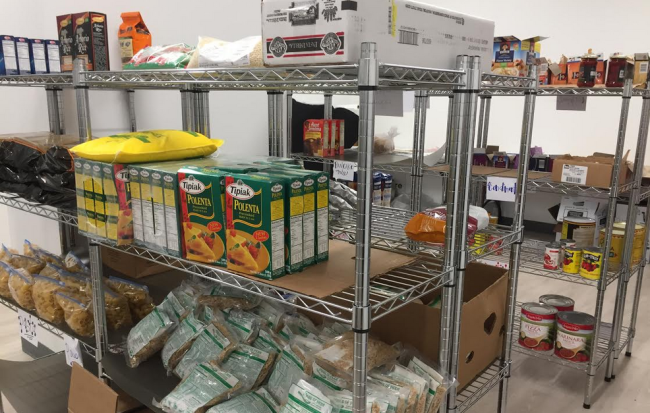You have /5 articles left.
Sign up for a free account or log in.

Food pantry at George Washington University
Kasia Kovacs
A door in the basement of George Washington University’s newest residence hall, still smelling of paint, is unremarkable. It has no sign.
Inside, it’s packed with food. Shelves are stocked with instant oatmeal, boxes of polenta, plastic bags of pasta, salt and pepper. Dairy and produce fill three refrigerators. A cardboard cutout of a hippo, the unofficial mascot of GW, greets visitors near the door: “Welcome to The Store!” it says in a thought bubble.
This isn’t technically a store, though, because students don’t have to pay for these items. It’s a food pantry for hungry students, and it’s one of 395 member food banks of the College and University Food Bank Alliance. Four years ago, when the organization began, it only had 15 members. The group got a significant jump in membership this time last year, when it hit 300 members.
Students at the GW store must sign out with the number of items they take, which is usually not a lot. One took three apples and a muffin. Another grabbed frozen ravioli and a roll of paper towels. But all students who come to The Store remained anonymous.
One left a note on a brown paper bag: “I just want to say thank you. I walked in and I felt terrified. I cried at how many options there are, and how much people must care to do this. Bless you all.”
Another student scribbled a note underneath: “May God bless you for such a well-thought idea. This is so beautifully done. I’m not a person with a rich family, so this really supported my financial needs. Seriously, may God bless you a thousandfold! Amen!”
A single mother left a note on lined paper: “You cannot imagine how much relief this gift has brought me on so many levels. Yes, we go to GW. Yes, we sometimes can’t afford food. Thank you for hearing our voice and caring. I love you, too.”
These students are not anomalies at the private university in Washington. The Store held a soft opening Sept. 21. Twelve students attended. By the end of October, 267 students were coming to the food pantry per day.
Like many colleges, GW opened its food pantry thanks to a philanthropic donation. This initial money will last four years, said Tim Miller, associate dean of students at GW, and The Store restocks every two weeks with food that it purchases from the Capital Area Food Bank.
Policy Predicaments
One reason that colleges and universities have felt the need to take student hunger upon themselves: in many cases, efforts to curb hunger through legislation have been arduous.
“What’s challenging in this area is that you don’t have [congressional] committee leadership over the same funding streams,” said Amy Ellen Duke-Benfield, senior policy analyst at the Center for Law and Social Policy.
In other words, legislation on the Pell Grant is sent to the Education and the Workforce Committee, but when it comes to the Supplemental Nutrition Assistance Program, those bills go to the Committee on Agriculture. That makes it more difficult to enact a coordinated policy change.
In June, Representative Bobby Scott, a Virginia Democrat, added an amendment to the Child Nutrition Act that would have expanded the National School Lunch Program to help college students. Students who qualified for financial aid would also qualify for subsidized lunches, according to the policy -- which was proposed by the Wisconsin HOPE Lab. But when the amendment was considered by the House Education and Workforce Committee, it was withdrawn.
That doesn’t mean all change concerning student hunger is in perpetual limbo. Earlier this year, Oregon State University and Humboldt State University began accepting SNAP benefits, which are provided to low-income people to promote health and nutrition. The universities needed to make sure that their grocery stores met federal standards, which meant stocking a variety of foods, such as fresh fruit and vegetables. Those are rare college success stories, thanks to the long and convoluted process involved in applying for the federal aid program.
What’s Next? More Data
When it comes to student hunger, a lack of data is a problem.
“We wish we had better data,” said Katharine Broton, researcher at the Wisconsin HOPE Lab and doctoral candidate in sociology at the University of Wisconsin Madison. “We first started collecting data on student hunger seven years ago. But it’s hard to tell if it’s gotten better or worse, because we’re looking at different populations and different schools.”
A study released last month looked at both community colleges and four-year colleges, but it used a convenience sample -- colleges were chosen based on whether they had volunteers willing to ask students to fill out surveys; the report notes that the survey may have “oversampled students with a tendency toward food insecurity.”
Since the study is based on a convenience sample, it cannot be generalized to the public. But what it does do is provide a snapshot into the lives of 1,800 food-insecure students, said James Dubick, an author of the report and an organizer with the National Student Campaign Against Hunger and Homelessness.
Some findings from that snapshot: 15 percent of food-insecure students had experienced some sort of homelessness in the past year; 32 percent believed that their hunger or housing problem had a negative impact on their education; and 56 percent of food-insecure students reported having a paying job.
“There are a lot of folks out there who are doubtful that this is still an issue, so it’s validating to see the research back up anecdotal elements and other research out there,” said Clare Cady, director of the College and University Food Bank, one of the organizations that sponsored the research.
Many of those students are working. Of the students who said they were employed, 38 percent worked 20 hours or more per week. This finding challenges the assumption that students who are hungry are simply lazy or entitled, said Duke-Benfield of CLASP.
“You hear some people say, ‘I worked my way through college,’” she said. “But that was a long time ago. Now you could work a full-time job in college and still not cover all your costs of going to school.”
The causes of student hunger become even more complicated when considering community colleges, where a significant number of students are not dependent on parents, do not live in student housing and are enrolled part time.
The report found that 25 percent of students at two-year community colleges have very low levels of food security, as compared to 20 percent at four-year institutions. A study from last year, conducted by the Wisconsin HOPE Lab, looked exclusively at community colleges. It found that one in five students have very low food security, and that 13 percent were homeless.
Currently, the HOPE Lab is working with the Association of Community College Trustees to measure food and housing security in 75 community colleges, a much broader scale than any previous study -- and an effort to collect better data in an area where current numbers are lacking.




